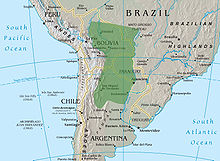Gran Chaco people
The indigenousGran Chaco peopleconsist of approximately thirty-five tribal groups in theGran Chacoof South America. Because, like theGreat Plains of North America,the terrain lent itself to anomadiclifestyle, there is little to no archaeological evidence of their prehistoric occupation. Contributing to this near-absence of archaeological data is the lack of suitable raw material for stone tools or permanent construction and soil conditions that are not conducive to the preservation of organic material.[1][2]
Geography
[edit]The actual cultural area of the Gran Chaco peoples differs from that of the geographic Gran Chaco. The northwestern boundary of the cultural area is theParapetí Riverand the marshes of the Bañados de Izozog depression, beyond which were the lands of the cultural unrelatedChanéandChiriguano.The cultural boundaries have not been static, even during historical times. In the late 17th century the area expanded to the east across theParaguay River,when theMbayáinvaded the lands between theApa Riverand theMiranda RiverinMato Grosso do Sulprovince in Brazil.[3]
Languages
[edit]The tribal groups of the Gran Chaco fall into sixlanguage families:[4]
- Matacoan languagesor Mataco-maká (Wichí languages,Chorote languages,Nivaclé languagesand theMaká language)
- Guaicuruan languages
- Lule–Vilela languages
- Mascoian languages
- Zamucoan languages
- Tupi–Guarani languages
Many of the languages are part of aChacolinguistic area. Common Chaco areal features includeSVO word orderandactive-stativeverbalignment.[5](See alsoMataco–Guaicuru languages.)
See also
[edit]- Campo del Cielo
- Classification of indigenous peoples of the Americas#Gran Chaco
- Gran Chaco#Indigenous peoples of the Gran Chaco
References
[edit]- ^Combes, Villar & Lowrey 2009,p. 71
- ^Calandra, Horacio Adolfo; Salceda, Susana Alicia (2008)."Cambio y continuidad en el Gran Chaco: De las historias étnicas a la prehistoria".In Braunstein, José; Meichtry, Norma C. (eds.).Liderazgo, representatividad y control social en el Gran Chaco.Corrientes, Argentina: Universidad Nacional del Nordeste. pp. 31–38 [32–33].ISBN978-950-656-116-1.
- ^Métraux 1946,p.197
- ^Combes, Villar & Lowrey 2009,p. 69
- ^Campbell, Lyle;Grondona, Verónica (2012). "Languages of the Chaco and Southern Cone". In Grondona, Verónica; Campbell, Lyle (eds.).The Indigenous Languages of South America.The World of Linguistics. Vol. 2. Berlin: De Gruyter Mouton. pp. 625–668.ISBN9783110255133.
Bibliography
[edit]- Combes, Isabelle; Villar, Diego; Lowrey, Kathleen (2009)."Comparative Studies and the South American Gran Chaco".Tipití: Journal of the Society for the Anthropology of Lowland South America.7(1): 69–102.Archivedfrom the original on 1 February 2014.
- Métraux, Alfred (1946). Steward, Julian H. (ed.)."Part 2: Indians of the Grand Chaco – Ethnography of the Chaco".Bureau of American Ethnology, Bulletin.1(143). Washington, D.C.: Smithsonian Institution: 197–370.
Further reading
[edit]- Sušnik, Branislava J.(1961).Apuntes de la etnografía Paraguaya, primera parte(second ed.). Asunción, Paraguay: Manuales del Musea Etnografía Andres Barbero.
- Renshaw, John (2002).The Indians of the Paraguayan Chaco: Identity and Economy.ISBN9780803289918.

